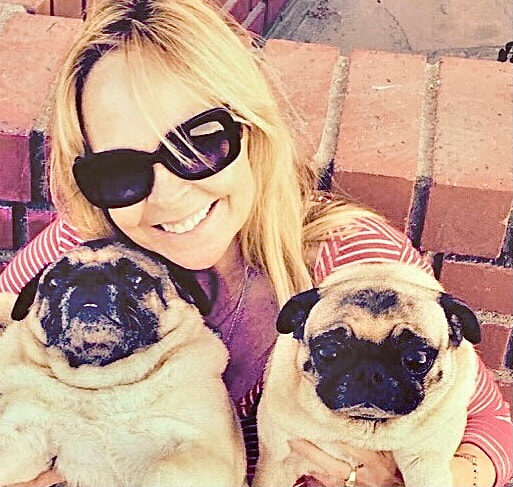|
By, Katy Cable A 4 min. Healthy Read It seems the Corona Virus is making everyone sick, whether you’ve tested positive or not! They say our dogs can detect our stress, fear and anxiety, and I believe it’s true. Ironically, even in the midst of this “soft apocalypse” which has many of us in a state of panic, our pups seem to be fairing quite well! Case and point, I’ve been on the brink, scrubbing my hands like Lady MacBeth, fighting with my husband over which movie we watch and who gets to pop out to the grocery store! In an effort to feel some sense of control, I’m obsessively taking inventory of our canned goods and toilet paper. Yet, for my pug Olive it’s “business as usual!” She’s flopped on the couch in a vegetative state, raising the roof with her snoring. The second I wave a morsel of cheese or chicken in front of her nose, she jumps in the air and dances. Any stress or anxiety is gone faster than the last roll of toilet paper at the market! While many of us are stuck at home and practicing social distancing, this is a great time to stretch your dollar while improving your dog’s diet AND overall health with a few easy tips. Remember: When adjusting your pet’s diet, or introducing new foods: GO SLOWLY, and GO SMALL! Avoid making too many changes at once. If you notice oily or runny stools, you’ve gone too fast and you need to cut back. Also see my blog with FOODS to AVOID! 1. CHOOSE A HIGH QUALITY KIBBLE: First if all, DON’T BE FOOLED BY THE BAG! That cute dog and delicious meal You see pictured on the bag tells you NOTHING! It’s important to choose food that’s free of artificial preservatives. You can recognize these by the names BGS, BHT, or ethoxy. There are numerous reports that these are carcinogenic and can cause a host of damage to vital organs. Stay clear of foods containing: corn, wheat, soy, or dyes. These ingredients, unless otherwise stated, are genetically modified (GMO). Wheat is high in gluten. These undesirable ingredients are shown to cause allergies, inflammatory bowel disease and cancer. Next, choose a kibble with meat as the first and second ingredient. Less expensive kibble is filled with starchy, high-carb protein like corn, peas, potatoes and rice. 2. USE A VARIETY OF FOODS: Just like you wouldn’t want to eat the same bowl of corn flakes for every meal, you dog doesn’t either. Not only is it boring, it’s risky. Should that particular food be sold out, discontinued or there’s a recall, your pet won’t be as vulnerable if you rotate varieties. Plus, you can help your pet avoid food sensitivities by introducing a variety of foods. If your dog is running low on their usual BEEF or CHICKEN kibble, try LAMB or TURKEY or another protein, adding a small amount in as you run out of the current variety. If your dog is sensitive, stick to foods with one single protein (limited ingredient formulas) and not a cocktail of meats. Also, watch my video on reading a food label and choosing foods that don’t contain harmful additives preservatives and rendered meats. I extensively research pet foods and would be happy to answer specific questions or provide recommendations. I look at recalls, lawsuits, change of ownership and many variables that can’t be found on the label. 3. Add FRESH, LIVING WHOLE FOODS: Lets face it, even the top-of-the-line kibble is highly processed food! It’s equivocal to eating fortified cereal for every meal. You can drastically improve you pet’s health by adding in fresh living whole foods. No, not your nachos and pizza, but yes to a bit of your fish, chicken, beef, fruit and veggies*. So save those trimmings and organs. Chop things up in small pieces and freeze them so you have healthy toppers to add to meals or use as healthy treats. Many companies offer varieties of bone broths, and meal toppers but it’s much less expensive to use your own. Be mi Dudley to avoid adding seasonings and sauces which are not good for your pet. 4. Add PROBIOTICS: Some kibbles contain probiotics. But they’re not that effective … because the live bacteria don’t survive high processing temperatures or long term storage. Nulo is one kibble that uses a highly sustainable probiotic in their kibble and treats but you can also use healthy fermented foods such as: plain kefir (1-2TBS) goat’s milk kefir, plain Greek yogurt, and fermented veggies. The good bacteria in probiotics help balance the gut … and crowd out the harmful bacteria! Adding probiotics will support your dog’s intestinal flora boosting good digestion and immunity! 5. OMEGA 3’s, 6’s and Fatty Acids: Most kibble diets don’t contain healthy fats. Even if they’re on the ingredient list … they’re lost with heating and processing. Kibble-fed dogs need to eat more healthy anti-inflammatory foods. Not surprisingly …. a carnivore best uses the omega-3 fatty acids found in fish oils. But there are some things you need to watch out for … Fish oil is very unstable and its quality varies tremendously. And rancid fish oil is worse to eat than no fish oil at all. Don’t believe that fish oil already contained in kibble can be fresh. I personally use fresh salmon, or human grade canned salmon, anchovies, or sardines and feed one or two small fish a week to provide a yummy topper and a good source of these omega fatty acids. By following these 5 easy recommendations, you’ll vastly improve your dog’s quality of life and health! I guarantee you’ll be thrilled with the results. Don’t be surprised if you find they have more energy, shinier coats and much more excitement at mealtime. Now...your dinner is another story! Pugs and Kisses, -Katy & Olive *In the case of diarrhea, try cutting back on new foods and adding 1-2Tbs canned pumpkin. |
PARTNERSHIPS
...Let’s Work Together
I love collaborating with other influencers and brands! Whether you need assistance with social media, creating an unforgettable event or want to be featured in my nationally syndicated blog, I can help. Let’s talk!


